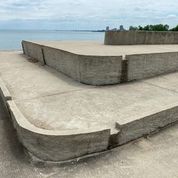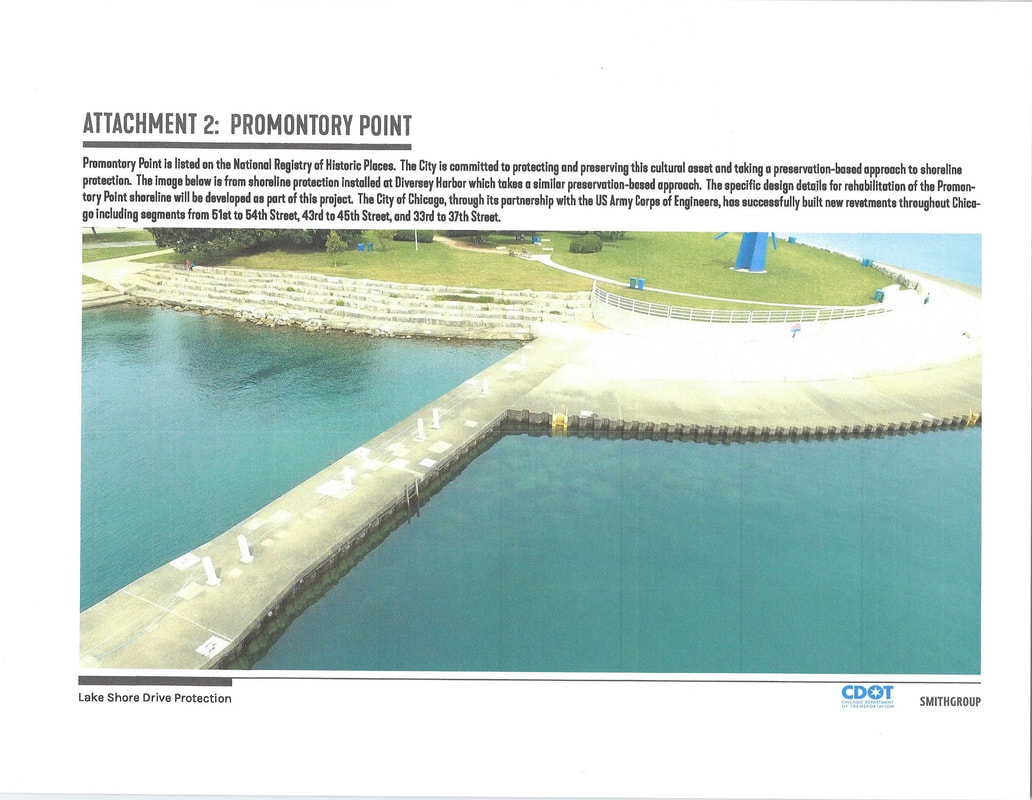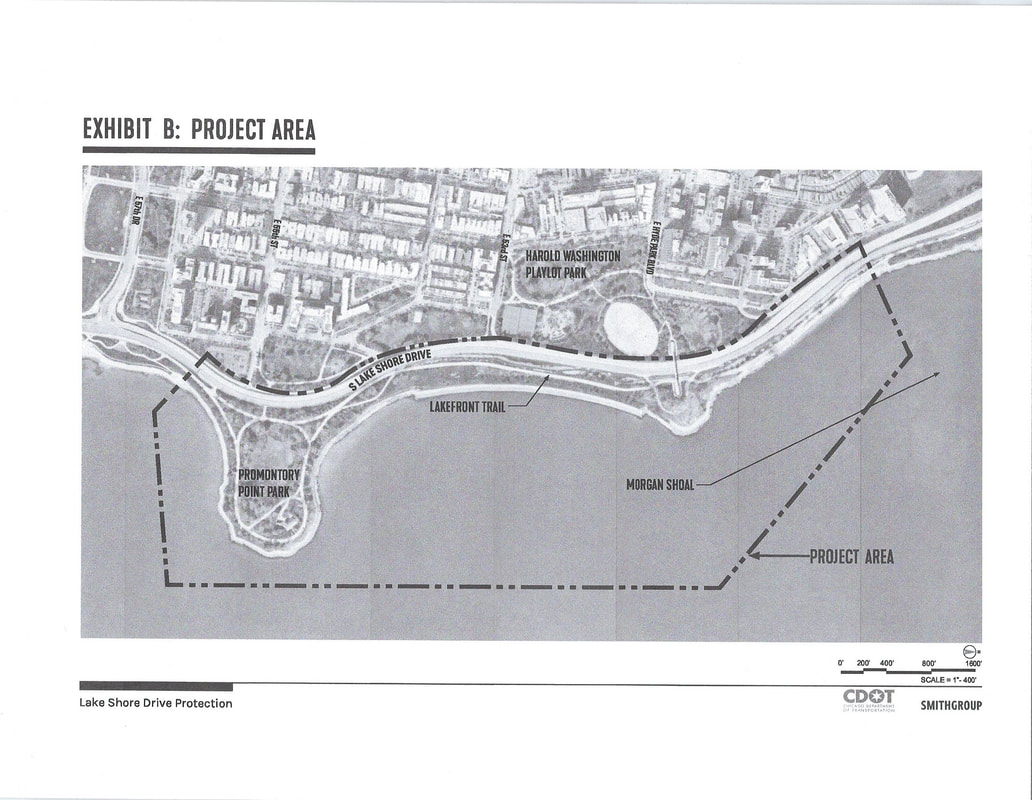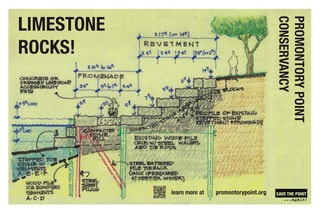|
On June 5, the Conservancy hosted a Q&A session about McLaren's condition study for preservation agencies, preservation organizations, the Army Corps, City and Chicago Park District. Here is the recording (55 min.
0 Comments
First, it's very important to know that the "locally preferred plan" is NOT the plan locally preferred by the community. As it currently stands, the “locally preferred plan” is demolition of the limestone revetment and new construction of textured concrete with decorative and ornamental limestone blocks in the parkland. This is what the City (CDOT) and the Chicago Park District (CPD) call the "locally preferred plan" and what they currently plan for the Point. We know that's what CDOT and CPD are planning from public information. First, on CDOT’s Shoreline Protection Project webpage, CDOT clearly states what the “locally preferred plan” is and what they mean by preservation: “The preferred design of the revetment is vertical steel sheet piles to replace the damaged wood piles, and concrete steps and promenade to replace the existing stones. This design maintains safe access to the shoreline while preserving its historical and aesthetic value.” (Promontory Point and Morgan Shoal are listed as "Reach 4-step stone revetment reconstruction from 23rd Street to 57th Street alongside Lake Shore Drive” on the same webpage.) Also, through FOIA, the Conservancy obtained CDOT's BRIC FEMA Pre-application, dated September 30, 2020. On page four of the exhibits, CDOT clearly specifies exactly what it means by "a preservation based approach" at Promontory Point: a new revetment of textured concrete with decorative limestone blocks in the parkland. CDOT engineers confirmed the "locally preferred plan" as recently as October 18, 2022 when the Conservancy walked the Point with CPD and CDOT commissioners and senior staff. In the exhibit pages below excerpted from the BRIC FEMA Pre-application, CDOT and SmithGroup (CPD's favored engineering/planning firm) layout the emergency storm erosion crisis project area and illustrate what the "locally preferred plan" looks like for Promontory Point. As you can see, Promontory Point -- where there is no storm damage erosion crisis and no threat to private property, DuSable Lakeshore Drive or human life -- is falsely bundled with Morgan Shoal as one emergency reach. And the color illustration spells out a purported "preservation based approach" of demolition of the historic limestone revetment and replacement with a concrete revetment. Here, like at 57th Street Beach's concrete revetment, limestone blocks are placed in the nearby parkland for decorative and ornamental purposes and do not function as the revetment. Illustration above: CDOT and SmithGroup's caption reads: "Promontory Point is listed on the National Registry of Historic Places. The City is committed to protecting and preserving this cultural asset and taking a preservation-based approach to shoreline protection. The image below is from shoreline protection installed at Diversey Harbor which takes a similar preservation-based approach. The specific design details for rehabilitation of Promontory Point shoreline will be developed as part of [the Morgan Shoal Project]. The City of Chicago, through its partnership with the US Army Corps of Engineers, has successfully built new revetments throughout Chicago including segments from 51st to 54th Street, 43rd to 45th Street, and 33rd to 37th Street." Obviously, the Conservancy, other preservationists and qualified marine engineering firms with preservation experience disagree with this assessment entirely. Map above: Bundling Promontory Point in a single reach with Morgan Shoal and calling it one project allow CDOT and SmithGroup (CPD) to inflate and exaggerate erosion, storm damage conditions at Promontory Point. CDOT and CPD lump Promontory Point into the second phase of work of the Morgan Shoal Project. Construction has already been awarded to SmithGroup and its partners to begin construction at Morgan Shoal. It's not clear whether that contract includes Promontory Point too in the scope of work. Right now, the City and CPD are fully funded for construction of the current "locally preferred plan" of demolition and a new concrete revetment at Promontory Point and Morgan Shoal. On December 15, 2022, the City won 65% federal funding for its "locally preferred plan". With the passage of the Defense appropriations by Congress, the City and CPD received federal funding appropriation to construct the "locally preferred plan": 65% funding for demolition and a new concrete revetment funnels through the Chicago Army Corps, and the City will pay 35% through its November 2020 General Bond Obligation offering which specifically names Morgan Shoal and Promontory Point as capital projects. The Army Corps, the Mayor's Office and CPD snuck this huge federal appropriation in without informing U.S. Congresswoman Robin Kelly in whose district the Point sits and who has persistently requested federal funds for preservation at the Point and without informing Alderman Leslie Hairston.
Based on circumstancial evidence and the agencies' ongoing obfuscations, the Conservancy believes that the Corps, the City and CPD are using the current General Reevaluation Study (GRR) of the Chicago lakefront, including Promontory Point, to back into CPD's SmithGroup study for demolition and a new concrete revetment at the Point. As confirmed by CPD last June, SmithGroup has completed Phase I (condition/assessment study) and Phase II (design/strategic action plan) for Promontory Point. CPD has refused to release these findings to the press, to elected representatives and to the Conservancy. Neither SmithGroup nor the Chicago Corps has any relevant preservation expertise to make a legitimate plan for a preservation approach at Promontory Point. The terminology "locally preferred plan" comes from the U.S. Army Corps of Engineers which must distinquish between its plan (cheap rubble mound) and the plan preferred by its local clients, CPD and CDOT. Hence, the "locally preferred plan". If the CPD and CDOT were sincere about preservation and listening to the wishes of the community, a genuine preservation approach -- such as the Conservancy's preservation marine engineering studies -- could be adopted by the agencies as the "locally preferred plan". To date, neither the Mayor's Office, CPD, CDOT nor the Corps has supported genuine preservation -- repair and restoration -- at the Point. Cost Points: cost comparisons of the "locally preferred plan" and preservation construction11/1/2022  We recently discovered -- again -- that repair, restoration and rehabilitation of Promontory Point continues to be cost-effective and cheaper than the City's "locally preferred plan". As you may recall, the City's "locally preferred plan" entails demolition of the historic limestone revetment and new construction of concrete and steel. In 2013, the U.S. Army Corps of Engineers' cost estimate for the "locally preferred plan" was $57m. Adjusted for inflation, the cost of the "locally preferred plan" today is: $75m In sharp contrast, preservation of the Point -- repair, restoration and rehabilitation per the Secretary of the Interior Standards for Historic Preservation -- continues to be cheaper than demolition and new construction. The 2002 Cyril Galvin preservation marine engineering report estimated the cost of repair, restoration and rehabilitation at $4.5m. Adjusted for inflation, that's currently $7.53m, 1/10th the cost of the "locally preferred plan". Given the storm damage erosion at the Point since 2002 and after conversation with four marine engineering firms with preservation experience, we estimate the cost of preservation construction and maintenance at 1/5 - 1/2 the cost of the "locally preferred plan" at: $17-29m Right now, the City is pushing a deception Point: demolition of the limestone revetment, new construction of a concrete revetment with limestone blocks on top as decorative and ornamental. Astronomical to build and to maintain, it is an over-engineered solution for $100m when repair, restoration and rehabilitation of the existing limestone revetment is feasible and multiple times cheaper. This is not a preservation-based approach and violates the Secretary of the Interior Standards for Historic Preservation. We don't need a new concrete revetment. We need the existing limestone revetment -- which still functions at 85 years -- fixed. But even if preservation costs as much as the "locally preferred plan" which it doesn't, Promontory Point would be worth it and park equity on the South Side would be served. |
Categories
All
Archives
July 2024
AuthorDebra Hammond is currently an officer of Promontory Point Conservancy. She has always been tall for her age |


